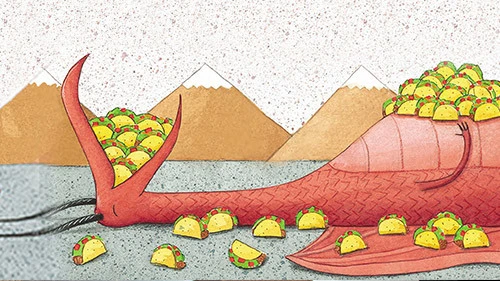Jean Raspail, Whose Immigration Novel Drew the Far Right, Dies at 94

Jean Raspail, an award-winning author best known for “The Camp of the Saints,” a novel that envisions a takeover of the Western world by immigrants from developing countries and that was embraced as a cautionary tale by white-supremacists, far-right political figures and a member of the Trump administration, died on June 14 in Paris.
His death, at a hospital, was confirmed by one of his publishers, Éditions des Équateurs. His funeral on Wednesday at the Church of Saint-Roch in central Paris drew more than 1,000 people, including many conservative public figures.
Mr. Raspail, a writer initially known for his travelogues, influenced generations of far-right readers with “The Camp of the Saints” (1973), in which he describes in denigrating detail how a million frazzled migrants from India reach the French Riviera and eventually take over the country.
For decades, its most fervent readers have declared it a prophecy of the extinction of Western white populations by vast numbers of newer arrivals, a theory known among white supremacists today as “the great replacement.” (The term was popularized by another French writer, Renaud Camus).
In New Zealand, the man who killed 51 people at two mosques this year named his manifesto “The Great Replacement.” And the shooter in the El Paso, Texas, massacre that left 20 dead last August mentioned the theory in a four-page screed he had written.
Mr. Raspail “was one of the last members of the old, reactionary right in France, and his death is seen as a major loss for those circles,” said Jean-Yves Camus, an expert on extremist movements (and no relation to Renaud Camus).
“The Camp of the Saints” gained attention in the United States last year, when it was revealed that as a Senate aide before Mr. Trump became president, Stephen Miller, now the president’s immigration adviser, had written approvingly of the novel in emails to an editor at the right-wing website Breitbart.
The former Trump strategist Steve Bannon also once asserted that European countries were confronted with an “invasion” that resembled the one described in “The Camp of the Saints.”
Mr. Camus told The New York Times in November, “People now buy ‘The Camp of the Saints’ because they want to read the book written by the writer who saw what would happen before everybody else.”
Jean Raspail was born on July 5, 1925, in Chemillé-sur-Dême, France, and spent his youth roaming North and South America, often in the footsteps of French explorers of the 17th and 19th centuries. He published his first travelogue, based on a trek from Tierra del Fuego to Alaska, in 1952.
He published dozens of travel books and fictional works set in Japan, the French West Indies, the Levant and Latin America. His novel “I, Antoine de Tounens, King of Patagonia” received the Académie Française grand prize in 1981. He was awarded its grand prize for literature, for his body of work, in 2003.
Yet it is “The Camp of the Saints,” which The Times and others have called a racist novel, that has become most closely associated with him. The novel dehumanizes the migrants, portraying them not as distinct individuals but rather as a mass of microbes, or rats. “To let them in would destroy us,” the narrator says. “To reject them would destroy them.”
The migrants occupy houses owned by white citizens, kill factory owners who had hired them, and rape white women and girls. The plot extends beyond France: In London, the white population leaves the city in trains while millions of dark-skinned people camp in the streets. In New York City, the mayor has to share his official residence with black families. In crude, racist terms, the narrator describes how a “black flood” reaches global Western cities.
Although Mr. Raspail repeatedly denied being a racist, he said he would not change a line of the book. In the magazine Le Point in 2015, he described himself as “right-wing, even right-right-wing.”
The novel was not markedly successful early on. When it was published in the United States in 1975, a Times review compared reading it to “being trapped at a cocktail party with a normal‐looking fellow who suddenly starts a perfervid racist diatribe.”
A new edition of “The Camp of the Saints,” published in France in 2011, became a best seller. Since then the us-vs.-them rhetoric has reached new readerships, many of them young, as Europe has faced a wave of immigration starting in 2015. In one of his last public appearances, in October, Mr. Raspail drew hundreds of fans for a book signing at a Parisian bookshop that promotes conservative writers.
In a foreword to the 2011 edition, he wrote that he was a “Français de souche, and proud to be so,” using an expression that, roughly translated, means people of French stock or of white European descent, a term often used in far-right circles. He predicted that the “white race” would be overwhelmed in the 2040s or 2050s.
He is survived by his wife, Aliette; a son, Quentin; a daughter, Marion; two grandchildren; and five great-grandchildren.
His funeral on Wednesday was one of the first large-scale gatherings in Paris since France eased measures to contain the spread of the coronavirus.
Marine Le Pen, the leader of the far-right party National Rally, has often cited “The Camp of the Saints” as a source of inspiration, having read it when she was 18, she s aid. On the day of Mr. Raspail’s death, she urged her Twitter followers to read the book, or to read it again.
For many of his supporters, what distinguished Mr. Raspail was not his xenophobia but the myth he had created around the territory of Patagonia, which spans Chile and Argentina. (He had jokingly declared himself consul general of it.)
“He had created his own world and community through his books in Patagonia,” said a longtime friend, Philippe de Villiers, a conservative writer and the founder of Le Puy du Fou, a historical theme park in western France. He added, “He knew that what matters for a population is its collective imagination.”




